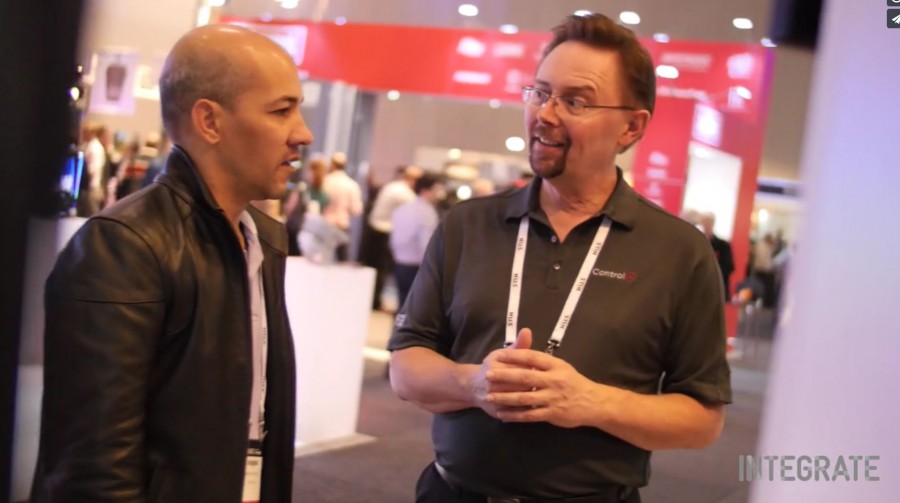

Control 4 is lives and breathes home automation. Their software connects smart devices like AV gear, blinds, lighting, security to make our lives better. Earlier this year I had a chance to speak to Robert Kidd, Managing Director at Control 4 Asia Pacific, about the company’s place in the Australian home automation market. The local distributor of Control 4 is Advanced Audio and both were at this year’s Integrate 2015 in Melbourne.
While it is possible for consumers to create DIY home automation solutions, this generally falls into the $1,000 and below price point. This piece meal approach can often leave consumers in the undesirable position of having to dive into a multitude of apps to control smart devices individually. What Control 4 offers is a comprehensive end-to-end solution and this comes at a cost. Typically Aussies can get into a Control 4 solution for around a couple of thousand dollars, while Kidd says the average installation in America is US$42,000, with the most extreme build costing north of 1 Million dollars.
Control 4 believes in “better together” which comes is a mentality realised in their scenes. The Control4 website lists ‘Bed time’, ‘Game time’ and ‘Date night’ as examples. In reality, there’s 6 key areas that Control4 can help with.. Home theature / entertainment, whole house audio, lighting, comfort, security and monitoring and communication. Combining the right mix of these device types, in the right way, is the key to unlocking that magical home automation experience we all dream of.
Having things work together brings a new kind of lifestyle not possible in other ways.
While community shared configurations like that of IFTTT recipies are awesome for individuals that happen to have the same set of equipment, Control 4 focuses on software for dealers (and installers). Control provides great programming tools with Composer and Composer Express, which both support conditional and boolean-based algorithms that can be created with simple drag and drop interfaces. This allows Control 4 to customise solutions for clients quickly and easily to precisely meet their needs. As the customer needs grow, they can quickly introduce new connected devices to their setup.
Control 4 now supports more than 8,500 devices and that list continues to grow, thanks to their presence on a number of standards bodies. The company says they aren’t interesting in making smart-hardware of their own, instead focusing on integration of new and existing products into their solution.
There’s some good talent in Australia in the dealership network that have traditionally been focused on Savant and Crestron that Kidd believes would be a great addition to the Control 4 family. This forms a strong part of the reason Control 4 attended the AV convention earlier this year, to showcase their solution to the industry.
To understand how Control 4 improve their offerings, I asked about the feedback system used to capture consumer sentiment. As with many modern companies, they consume multiple points of feedback from customers. Certainly social media (namely Facebook and Twitter), as well as feedback from their dealer advisory community, a dealer forum, as well as feedback tools built into the software to take signals about customer’s changing needs.
Control 4 Software releases are now on a twice a year cycle, a major and minor update and are now pushed over-the-air, while traditionally it was offered through the dealer. The latest software is version 2.8 which added things like native streaming services—including Pandora, TIDAL and Deezer.
Kidd believes Australia still feels like its lagging, maybe a year behind the rest of the markets Control 4 serves. Indicators show they need to do more work on increasing awareness of what’s possible. As someone building a house right now, I asked about the decision of consumers about installing home automation on a new build, versus adding smart home components or solutions later. Kidd certainly believes it depends on the situation and largely depends on the building material used.
If you’re building with wood and plaster, you can change things later, whereas those high rise buildings with cement, its far harder to implement technology after the fact. The ability to retrofit home automation into an existing property differs dramatically based on the market.
It’s not only OK, but its a really good strategy to start small and let consumers experience how one or two device work with a small implementation, then as their mind turns to whats possible, expand their solution later. Adding additional rooms, security systems, external lights and more are all possible later and in many ways.
Being able to open the closet doors and having the lights turn on automatically, may seem tripe, but really does bring a level of “wow that’s really nice” experience. Thinking through this opportunity to combine motion and presence detection with light, I put to Kidd that its entirely possible that within the next 10 years, its likely we’ll see a house being build that doesn’t have light switches. He replied, “without a doubt”. In many ways this is the promise of home automation, that our behaviours don’t just get simplified.


